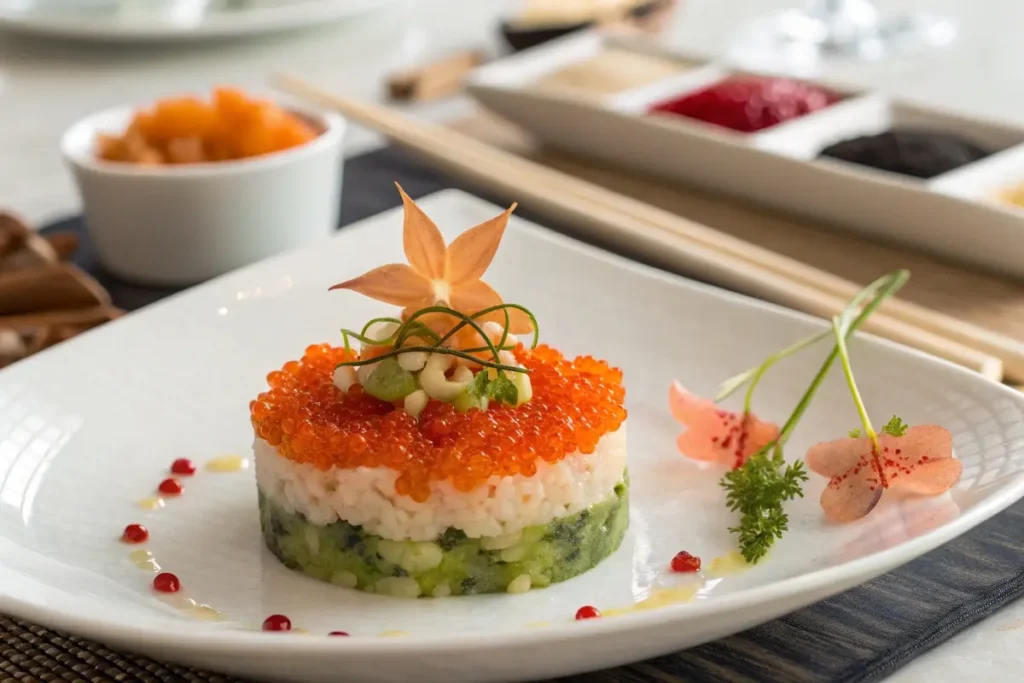Tobiko, the vibrant, crunchy flying fish roe, has earned its place as one of the most celebrated ingredients in Japanese cuisine. Revered for its brilliant colors, delicate texture, and subtle brininess, tobiko not only elevates sushi and sashimi but also inspires innovative culinary creations across the globe. This guide delves deep into the world of tobiko—from its origins and production to its nutritional benefits and creative uses in modern recipes. Whether you’re a seasoned sushi enthusiast or a curious foodie eager to explore unique flavors, this article provides a comprehensive look at tobiko, ensuring you understand every facet of this exquisite ingredient.
Discover more culinary treasures on our Japanese Steak Recipe page, where tradition meets innovation.
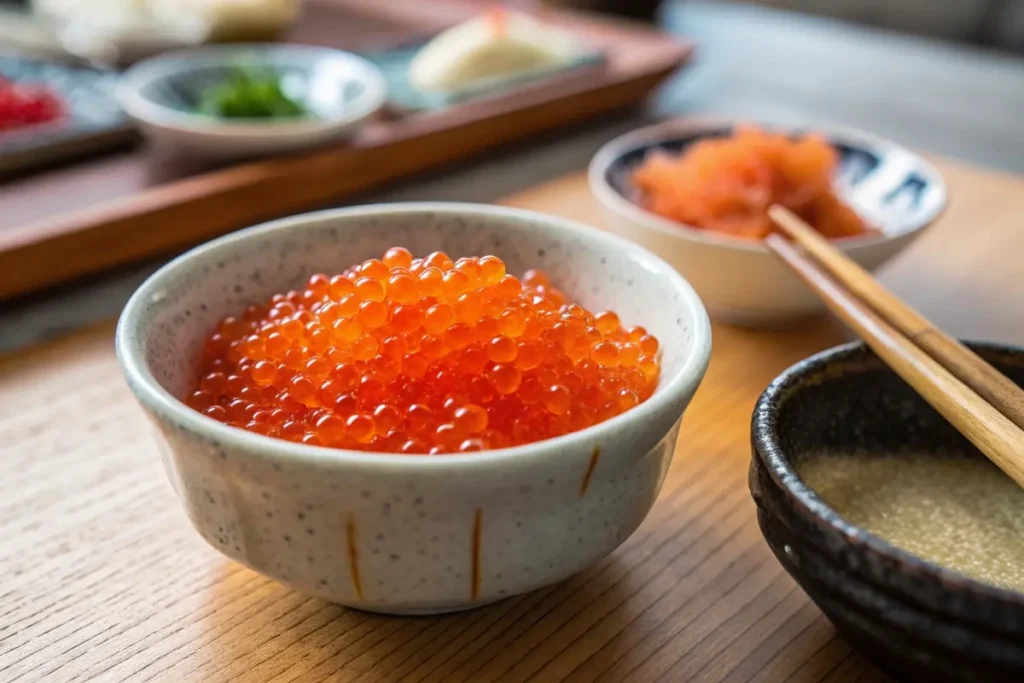
Table of Contents
What Is Tobiko? Unraveling the Mysteries of Flying Fish Roe
Tobiko is the small, crunchy egg of the flying fish, typically used as a garnish or ingredient in various Japanese dishes. Its natural luminescence and mildly salty taste make it a favorite among chefs and food enthusiasts alike. Despite its resemblance to caviar, tobiko offers a distinct flavor profile and textural contrast that sets it apart from other types of roe.
Key Characteristics of Tobiko:
- Color and Texture: Naturally orange, tobiko can also be found in different hues—black, red, green, and even wasabi-colored—each variant offering a unique twist in flavor and presentation.
- Taste Profile: With a slight brininess and an enjoyable crunch, tobiko adds both flavor and a textural contrast to dishes, enhancing both visual appeal and mouthfeel.
- Usage: Often sprinkled over sushi rolls or used as a garnish in various appetizers, tobiko is also increasingly featured in fusion recipes, from pastas to innovative appetizers.
The rising popularity of tobiko can be attributed to its versatility and its ability to transform an ordinary dish into an extraordinary culinary experience. It’s a star ingredient that bridges traditional Japanese gastronomy with contemporary culinary art.
Internal link: Explore our Japanese Chicken Fried Rice Recipe for more ideas on incorporating unique Japanese ingredients into your meals.
Nutritional Benefits and Culinary Uses of Tobiko
Tobiko is not only celebrated for its aesthetic appeal and flavor but also for its nutritional benefits. As a rich source of protein, omega-3 fatty acids, and essential vitamins, tobiko contributes to a balanced diet without sacrificing taste.
Nutritional Highlights:
- Protein-Rich: Tobiko is an excellent source of protein, making it a valuable addition to a diet that supports muscle repair and overall health.
- Omega-3 Fatty Acids: These healthy fats are essential for heart health and cognitive function. Incorporating tobiko into your meals can help boost your intake of these beneficial nutrients.
- Vitamins and Minerals: Tobiko contains vitamins such as B12 and essential minerals like selenium and zinc, which are vital for immune function and metabolism.
Culinary Versatility:
Tobiko’s vibrant color and crunchy texture make it a popular garnish for sushi, sashimi, and even modern fusion dishes. Chefs often use it to add a pop of color and a burst of flavor to their plates. Some popular culinary uses include:
- Sushi and Sashimi Garnish: A sprinkle of tobiko can transform the look and taste of sushi rolls and sashimi, offering a delicate crunch and subtle saltiness.
- Fusion Dishes: Innovative recipes incorporate tobiko into pastas, salads, and even desserts, where its visual appeal enhances the overall presentation.
- Sauces and Dressings: Blended into sauces, tobiko can add an umami depth and a textural twist, perfect for drizzling over grilled fish or vegetables.
For additional inspiration, check out our Traditional Japanese Desserts Recipe page to see how Japanese ingredients can be creatively used in various dishes.
How to Incorporate Tobiko in Modern Recipes
Modern cuisine continues to evolve by blending traditional ingredients with innovative techniques. Tobiko has found its way into numerous creative dishes that merge the boundaries between classic Japanese flavors and international culinary trends.
Innovative Recipe Ideas:
- Tobiko Pasta: Combine al dente pasta with a light cream sauce, fresh herbs, and a generous sprinkle of tobiko for a dish that marries Italian and Japanese flavors.
- Tobiko Avocado Toast: Upgrade your breakfast by topping avocado toast with a layer of tobiko, adding a delightful crunch and an unexpected burst of saltiness.
- Tobiko Salad: Enhance a fresh mixed salad with tobiko, citrus segments, and a zesty sesame dressing to create a dish that is both visually stunning and nutritionally balanced.
- Tobiko Risotto: Infuse a traditional risotto with the vibrant flavors of tobiko. The roe adds texture and an umami kick that pairs wonderfully with the creamy rice.
Tips for Cooking with Tobiko:
- Timing: Add tobiko to your dish just before serving to preserve its texture and brightness.
- Pairings: Complement tobiko with ingredients that offer contrasting textures—such as creamy avocados or crunchy vegetables—to create a balanced dish.
- Experimentation: Don’t be afraid to experiment. Use tobiko as a finishing touch on soups, pizzas, and even in fusion desserts to explore its full potential.
Internal link: For a taste of innovative fusion, visit our Japanese Curry Recipe One Piece page and discover how traditional ingredients are reimagined.
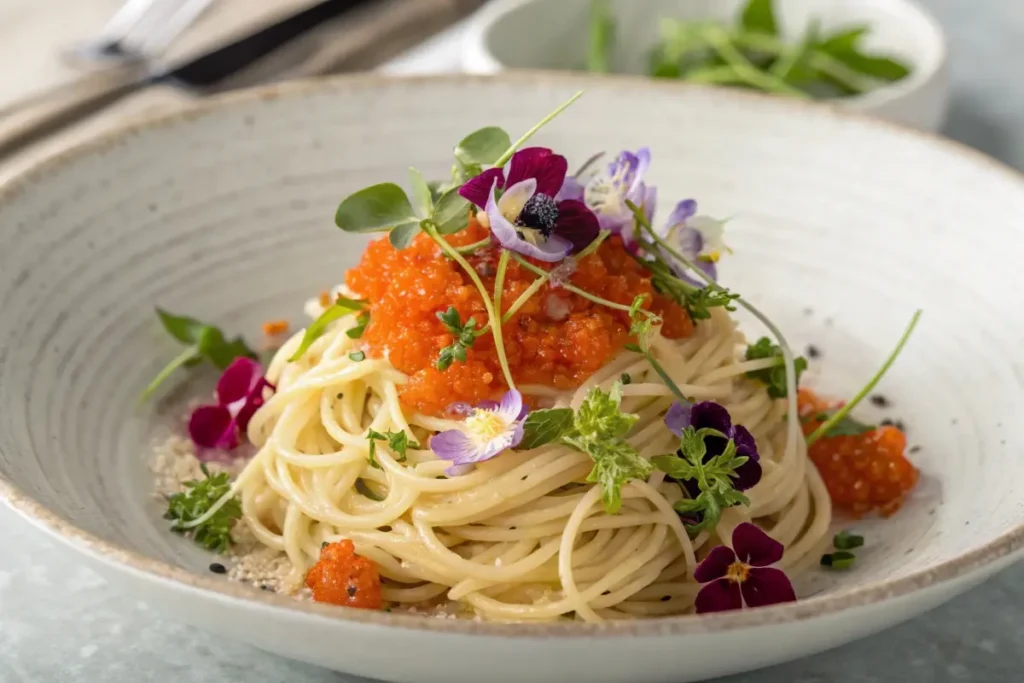
Tobiko vs. Caviar: Understanding the Differences
A common question among food enthusiasts is whether tobiko is simply a type of caviar. While both are types of fish eggs, tobiko and caviar differ significantly in terms of origin, taste, and texture.
Key Differences:
- Source:
- Tobiko: Harvested from flying fish, predominantly found in the waters around Japan.
- Caviar: Typically sourced from sturgeon and other larger fish species.
- Size and Texture:
- Tobiko is smaller, offering a crunchy texture, whereas caviar is larger and more delicate.
- Flavor Profile:
- Tobiko has a mild brininess with a subtle sweetness and crunch, making it versatile in various dishes.
- Caviar is known for its intense, salty flavor and a buttery, smooth texture.
- Usage in Cuisine:
- Tobiko is widely used in Japanese cuisine as a garnish and ingredient in sushi, salads, and fusion dishes.
- Caviar is considered a luxury ingredient, often served on its own or as a garnish for refined appetizers.
While both ingredients are prized for their unique qualities, tobiko’s versatility and vibrant presentation have helped it carve out its niche in modern gastronomy.
Internal link: Learn more about the subtle nuances of Japanese ingredients on our Japanese Vegan Recipes page, where natural flavors take center stage.
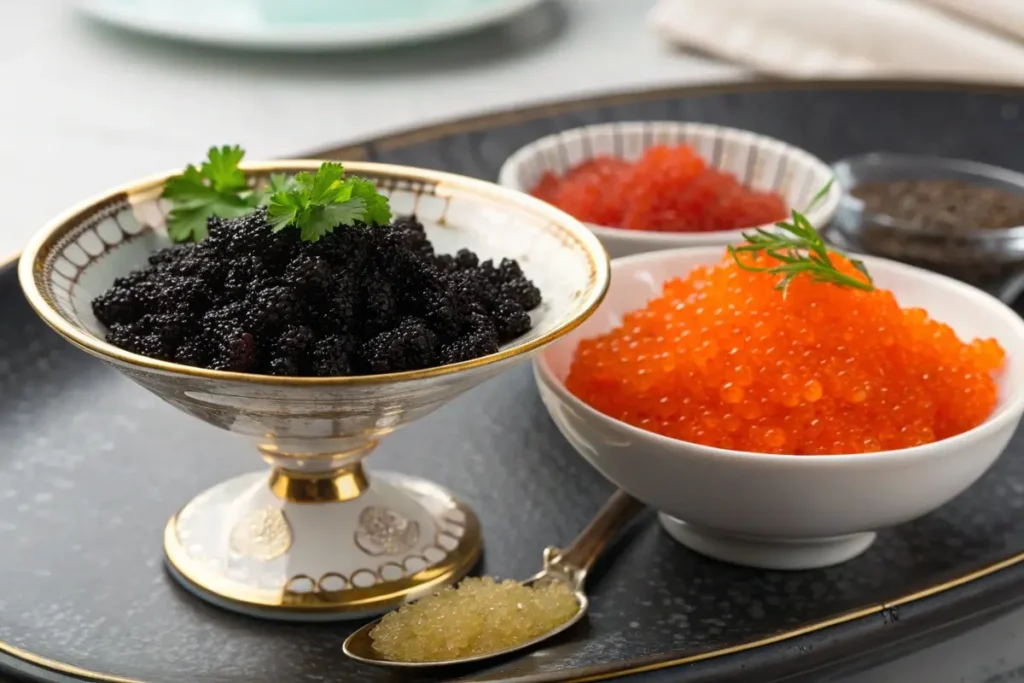
The History and Production of Tobiko
Understanding the journey of tobiko from ocean to table provides valuable insight into its cultural and culinary significance. Tobiko has a rich history deeply rooted in the traditions of Japanese seafood cuisine, and its production is a blend of natural processes and meticulous craftsmanship.
Historical Background
- Origins:
Tobiko has long been an integral part of Japanese cuisine, valued for its vibrant color and unique texture. Historically, fishermen would collect flying fish during seasonal migrations, and local chefs soon discovered the potential of using their roe to enhance dishes. - Cultural Significance:
Over time, tobiko became synonymous with celebration and refinement. Its use in sushi evolved as chefs began experimenting with flavors and textures, transforming simple dishes into gourmet experiences. - Modern Production:
Today, tobiko is produced through a combination of traditional methods and modern techniques. The roe is carefully harvested, rinsed, and often treated with natural flavor enhancers such as yuzu or wasabi to elevate its taste. Despite advances in technology, the essence of tobiko production remains rooted in respect for natural processes and a commitment to quality.
Production Techniques
- Harvesting:
Flying fish are caught during their seasonal migrations, and the roe is carefully extracted to ensure minimal damage. - Processing:
Once harvested, the eggs are washed, salted, and sometimes infused with natural flavorings. The final product retains a delicate balance of saltiness and subtle sweetness. - Quality Control:
Producers adhere to stringent quality control measures to ensure that every batch of tobiko meets high culinary standards, preserving its vibrant color, texture, and flavor.
Internal link: For a deeper dive into Japanese culinary heritage, visit our Japanese Beef Short Ribs Recipe page where traditional methods are celebrated in every dish.
Practical Examples and Use Cases
Tobiko’s versatility is showcased in a wide range of dishes, making it an ingredient that both professional chefs and home cooks can experiment with. Here are some practical examples of how tobiko can be used to elevate everyday meals.
Celebratory Dishes
- Sushi and Sashimi Enhancer:
A simple yet effective way to showcase tobiko is by using it as a garnish for sushi rolls or sashimi platters. Its vibrant hue and crunchy texture add a delightful contrast to the soft fish and rice. - Fusion Appetizers:
Create an innovative appetizer by mixing tobiko with avocado and a hint of lime, serving it on crispy wonton chips for a refreshing bite.
Everyday Recipes
- Tobiko Toast:
Spread mashed avocado on toasted sourdough, then top with a sprinkle of tobiko, microgreens, and a squeeze of lemon juice. This dish transforms a regular breakfast into a gourmet experience. - Gourmet Salad:
Toss mixed greens with cucumber, radish, and citrus segments, then finish with a drizzle of sesame dressing and a generous sprinkle of tobiko. The result is a refreshing salad bursting with texture and flavor. - Pasta with Tobiko Cream Sauce:
Elevate your pasta night by preparing a light cream sauce infused with lemon zest and finishing it with a spoonful of tobiko. The delicate balance of flavors creates an unexpected yet satisfying meal.
Internal link: For more creative recipes that blend traditional and modern techniques, visit our Japanese Curry Recipe One Piece page.
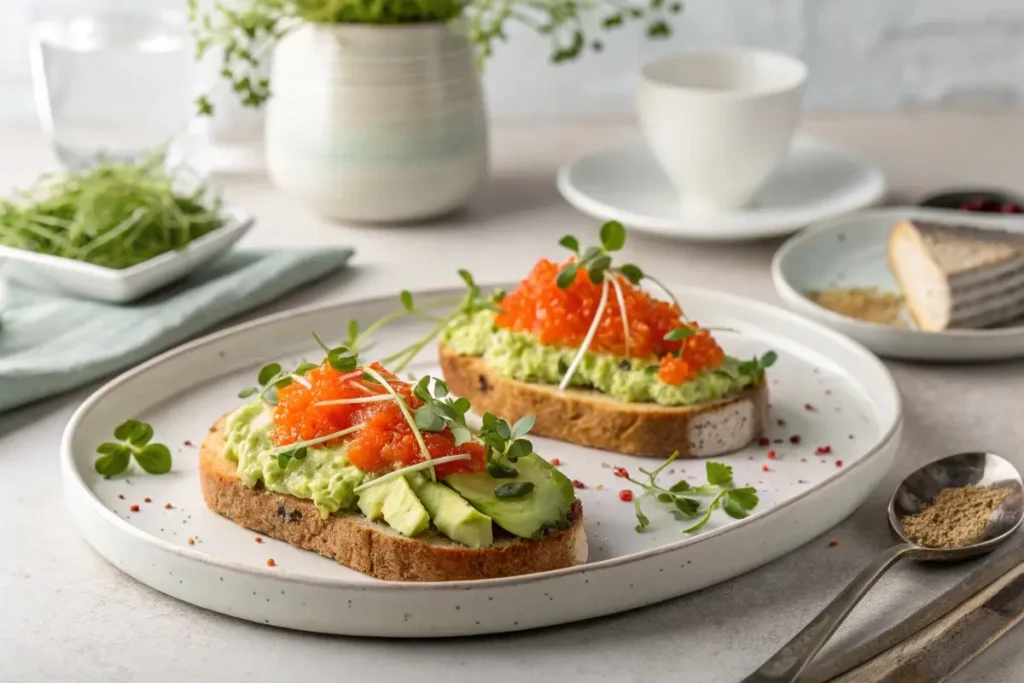
FAQs: Everything You Need to Know About Tobiko
Below are answers to some of the most commonly asked questions about tobiko. These insights help clarify its origins, uses, and unique properties, ensuring you can confidently incorporate this ingredient into your cooking.
1. Is tobiko actually fish eggs?
Yes, tobiko is the roe of the flying fish. Although it is often compared to caviar, tobiko is distinct in both flavor and texture, offering a unique crunch and a mildly salty taste.
2. What is tobiko?
Tobiko refers to the small, colorful eggs harvested from flying fish. Used primarily in Japanese cuisine, tobiko is prized for its vibrant hues—most commonly orange—and its ability to enhance both the visual appeal and flavor of dishes such as sushi, sashimi, and fusion recipes.
3. Is tobiko the same as caviar?
While both tobiko and caviar are types of fish eggs, they differ significantly. Caviar is typically sourced from sturgeon and is known for its delicate, buttery texture and intense flavor. Tobiko, on the other hand, comes from flying fish, offering a crunchy texture and a milder, slightly briny taste that lends versatility to various dishes.
4. Is tobiko gluten free?
Yes, tobiko is naturally gluten free. As a seafood product, it does not contain any gluten, making it suitable for those with gluten sensitivities or celiac disease. However, always ensure that any additional ingredients used in a dish with tobiko are also gluten free.
5. How is tobiko typically used in dishes?
Tobiko is most commonly used as a garnish on sushi rolls, sashimi, and other Japanese delicacies. Its bright color and unique texture make it an attractive addition to many dishes, and modern chefs often incorporate it into sauces, salads, and even fusion recipes to add an extra burst of flavor and visual appeal.
Internal link: For further reading on the nuances of Japanese ingredients, check out our Japanese Vegan Recipes collection.
Conclusion: Embrace the Brilliance of Tobiko
Tobiko stands as a testament to the ingenuity of Japanese cuisine—combining tradition, innovation, and a distinct burst of flavor in every tiny egg. Whether you’re enjoying it as a sophisticated garnish on a sushi roll or experimenting with it in fusion recipes, tobiko offers endless possibilities for culinary creativity. By understanding its origins, nutritional benefits, and unique characteristics, you can fully appreciate the role tobiko plays in enhancing both traditional and contemporary dishes.
As you continue to explore the vibrant world of Japanese ingredients, let tobiko inspire you to try new recipes and experiment with different flavor combinations. Embrace its crunchy texture and brilliant color to elevate your everyday meals into extraordinary culinary experiences. So, why not incorporate a little tobiko into your next dish and savor the subtle elegance and delightful complexity it brings?
Internal link: For more delectable recipes that blend innovation with tradition, visit our Japanese Dessert Recipes page and discover how Japanese cuisine continues to inspire culinary artistry.
